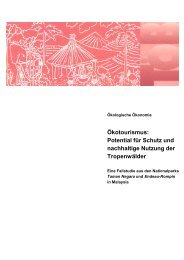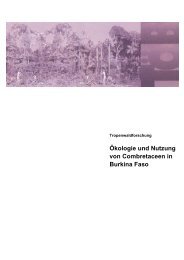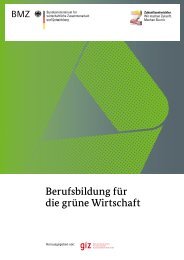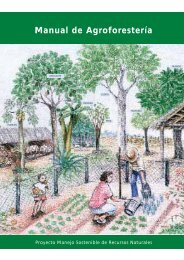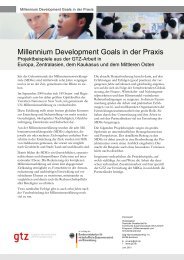Status Report on Global Neem Usage - Gtz
Status Report on Global Neem Usage - Gtz
Status Report on Global Neem Usage - Gtz
- No tags were found...
Create successful ePaper yourself
Turn your PDF publications into a flip-book with our unique Google optimized e-Paper software.
2. GLOBAL NEEM DISSEMINATION AND USAGE2. Remove pulpBefore drying the pulp should be totally removed from the seeds. This requires washingand scrubbing of the seeds.3. Dry the seedsNormally neem seeds are spread out in thin clean layers under shade and dried for severaldays. If the air is very humid, it may be necessary to dry the seeds directly in the sun forsome hours before drying for several days in the shade. If the drying c<strong>on</strong>diti<strong>on</strong>s are notadjusted, seeds begin to go mouldy, which can lead to a larger quantity becoming infected.Infected seeds or other impurities such as broken seeds, st<strong>on</strong>es, soil or parts of other plantsshould be sorted out. C<strong>on</strong>taminati<strong>on</strong> with storage pests, fungus or chemicals (pesticides)may cause problems when using or processing the seeds.StorageOnly good quality seeds can be stored for l<strong>on</strong>ger periods of time. The husk of the seeds mustbe intact and they should be kept in clean cloth bags or pots in dry c<strong>on</strong>diti<strong>on</strong>s. It is importantthat after drying the moisture c<strong>on</strong>tent of the seeds is around 8%. Ideally they should bestored at a low ambient temperature (10 – 20°C) and for no l<strong>on</strong>ger than <strong>on</strong>e year. Each batchof harvested neem raw material should be stored and marked separately.Quality standards of neem raw materialThe following table shows the minimum quality standards for all uses of neem.Table 2.3:Quality standards for raw materialRawmaterialSeedsCrushedneemseedsQualityparameterAzadirachtinc<strong>on</strong>tentMoisturec<strong>on</strong>tent of theseedsDegree ofpurity or c<strong>on</strong>taminati<strong>on</strong>Storage of dryseedsStorage andpackagingRequirementsMinimum 1.5 µg/gDrying under 8 %Clean seeds withoutpulp, impuritiesand no c<strong>on</strong>taminati<strong>on</strong>In large, well-ventilatedsacks for nomore than 2 years;Vacuum-packed inquality plasticbags (PE/PA);bags should berecyclableNotesLower values indicate faulty harvesting,drying or storage; or the seeds are to oldFaulty drying; the seeds cannot be storedfor a l<strong>on</strong>g time; they begin to go mouldy.Problems processing the seeds; impuritiessuch as st<strong>on</strong>es, soil or parts of other plants;no c<strong>on</strong>taminati<strong>on</strong> with storage pests orfungi, nor with chemicals (pesticides)Store-room have to be dry, clean, ventilatedand without c<strong>on</strong>taminati<strong>on</strong> of storagepests or fungus; neither chemicalsStorage maintains c<strong>on</strong>stant quality andfreedom from impurities and moisture for atleast 2 years; this means that moisture andair should not penetrate the bag15



